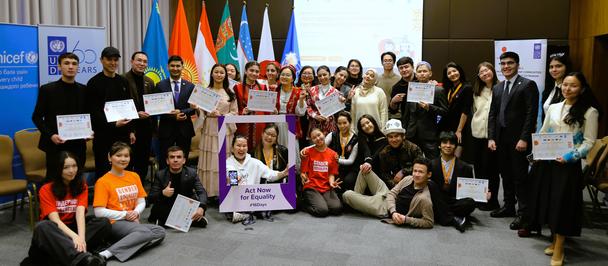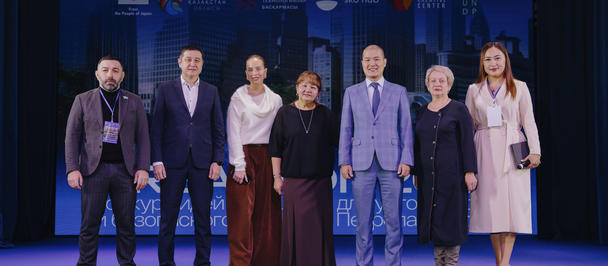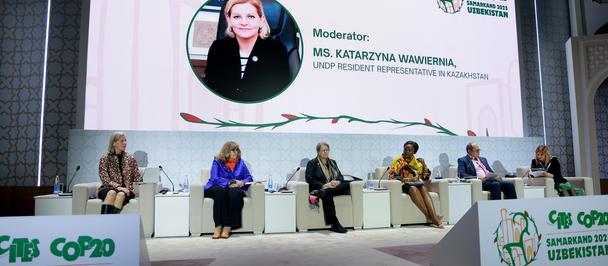Leading with purpose: Raushan and the future of Kazakhstan’s protected area
May 21, 2025

Raushan Krykbaeva in the field — standing against the Altai peaks
For 24 years, Raushan Krykbaeva has been at the heart of scientific research and conservation in Katon-Karagay National Park — Kazakhstan’s largest protected area. A pioneer in the park’s founding years, she now leads a team of researchers working to protect rare species, monitor ecosystems and build cross-border partnerships for global biodiversity.
The Katon–Karagay National NaturePark, thelargest park in the country, is located at the junction of four countries– China, Kazakhstan, Mongoliaand Russia. For more than 20 years, new species of flora and fauna have been discovered here and this is a testament to the contribution of Raushan Krykbaeva
When the nature park had just been established in 2001, much had to be built from scratch, including a scientific foundation and a monitoring system. As one of the pioneering specialists, Raushan remembers how everything had to be developed gradually—with little more than dedication, enthusiasm and faith in science to guide the way.
"It was not easy at the beginning, but people in the national park were enthusiastic and dedicated. We went into the field, followed survey routes and uncovered the natural wonders of Eastern Kazakhstan. From the very beginning we were shaping the scientific core of the park– it was a thrilling journey,"says Raushan.

Raushan Krykbayeva has studied biodiversity in Kazakhstan’s largest national park for over 20 years
Relocating to the Roots: A Turning Point in Raushan’s Life
In the 1990s, Raushan moved with her family to the East Kazakhstan region, the homeland of her husband, Bolat. The move marked the beginning of a new chapter, a difficult but momentous one.
"I was unemployed for the first five years. It was difficult, because I'm not someone who can sit idle. Bu then nature saved me: I came to the river, felt its cool breeze, watched the flowing river and understood that it was taking my worries with it ,"Raushan reflects.
When recruitment began for the newly established Katon-Karagay National Park was announced, Raushan joined the Department of Science and Environmental Monitoring. There was a sense of excitement, but a strong desire to help lay the foundation for the park's development. Fortunately, she was surrounded by people who shared her belief in the mission. And so, the study of nature became her life’s work.


Before joining the park, Raushan spent 10 years at the Forestry Research Institute in Tashkent
Where leadership meets the landscape
Nowadays, Raushan is the Deputy of Chief Executive Officer for Science of the National Park. She spends her working hours not in an office, but out in nature –among the snowy peaks of the Altay Mountains and the Park's picturesque meadows. She and her colleagues study the flora and fauna of the region, monitor rare species, organize expeditions, and participate in international projects. Thanks to her leadership, dozens of previously undocumented plant and animal species were identified, expanding the biodiversity records not only of the park but of Kazakhstan as a whole.
Raushan works alongside five other specialists in the science department, a team she is deeply proud of. Two ofthem areco-authors of the Red Book of Kazakhstan, and data on the flora and fauna of the national park are publishedin the Global Biodiversity Information Facility database.


Raushan and five colleagues study local wildlife and publish in scientific journals
Raushan's work is more than just about numbers and reports. She knows where certain species "live", at what time of the year a particular plant blooms and how populations differ in different natural altitudes. She plays a vital role in keeping in sustaining the nature conservation system going, not from behind a desk but on the ground, along field routes.
"I could never see myself working in an office. I need to feel the earth under my feet, hear the birds sing, the wind whisper, the water flow – to keep moving. Even when I was young, I knew that nature was where my strength came from",
says Raushan.
For Raushan, nature offers both purpose and peace
The work of the science department extends beyond national research. It also contributes to global biodiversity. In 2004 the National Park established partnerships with the Katun Biosphere Reserve in Russia,and in 2017, as a result of this cooperation, the Katon-Karagay National Nature Park became part of the UNESCO World Network of Biosphere Reserves as a core component of the Great Altay Cross-border Reserve.

Katon-Karagay National Nature Park is the largest park in Kazakhstan covering over 600,000 hectares
Where Borders Meet and Biodiversity Thrives
Katon-Karagay National Park is unique not only for its location at the crossroads of four countries, but also for its extraordinary natural richness. The part is home to more than 2,000 plant species of which 30 are listed in Kazakhstan's Red Book of endangered species. Forests cover over 40 percent of its territory forming the southernmost border of the Siberian taiga. Among the rare and remarkable flora found here are the Rhodiola rosea, Altay rhubarb, Siberian kandyk, Venus' slipper, steppe peony, and many others.
Scientific work in the park is carried out in a systematic and consistent manner. Under the leadership of Raushan and her colleagues, studies on vascular plants, rare species of birds and mammals are ongoing. The team also maintains a detailed chronicle of nature. Thanks to the collaboration with scientists such as professor Konstantin Prokopov and ornithologist Sergey Starikov, a large-scale inventory of flora and fauna was carried out. These studies continue to this day. From 2019-2024, 20 new species of invertebrates and eight species of birds were discovered here.
More than 300 species of birds live and nest in the national park
The park is a haven for biodiversity. A total of 301 bird species have been registered here, of which 26 are listed in Kazakhstan's Red Book. These include the saker falcon, the Altay ular, the steppe eagle, the demoiselle crane and even the elusive pink flamingo. In addition, 67 mammal species inhabit the park, including the endangered snow leopard, the elusive manul and the rugged Altay mountain sheep.
The work of the scientific department is not limited only to the territory of the park. The department specialists regularly participate in field trips to other regions, including the Zhongar-Alatau State Natural Park and the Katon-Karagay Biosphere Reserve. The neighbouring ecosystems of the East Kazakhstan region are also being studied.
"Together with colleagues from neighbouring countries, we are working to preserve the unified ecosystem of the Altay-Sayan ecoregion. Nature knows no borders – and neither should science,"says Raushan.
Between 2019 to 2024, about 46 new species were discovered in the park, spanning plants, birds and invertebrates. But she believes this is only the beginning – the park is immense, and much of its biodiversity remains unexplored.


Raushan and her colleagues carrying out biodiversity research
Modern tools and global expertise for a growing park
The United Nations Development Programme (UNDP) in Kazakhstan has played a key role for in supporting the development of scientific, environmental and tourism activities in the park. With its support, the park has acquired modern equipment, introduced advanced biodiversity and ecosystem monitoring systems, developed new tourist routes and launched virtual tours. Expert and methodological support was also provided, along with training sessions and experience-sharing initiatives that have helped strengthen human resource capacity. Nevertheless, for sustainable work and further research, resources are needed – particularly transport equipment and opportunities for the continued exchange of experience.
Raushan says that she is especially inspired by the growing interest in the park among schoolchildren and volunteers. Environmental activities are regularly organized in nearby schools, offering hope that the next generation will carry forward the mission of protecting and studying nature.
For Raushan, family has always been a pillar that strengthens her dedication to nature. Her husband, a colonel in the reserve, also has deep roots in conservation — having previously worked in forestry, following in his father’s footsteps.
"What unites our family is a deep love for nature. On weekends, we retreat to her for strength. Even in hard times, nature was there for us — she gave us comfort, and she gave us work,”Raushan reflects.

Raushan takes a break from her busy schedule
Leading with Knowledge, Guided by Duty
Today, more than 350 people work in the Katon-Karagay National Park, including 40 women, some of whom, like Raushan, hold senior positions. She believes that nature conservation is a shared responsibility, one that requires not only knowledge, but also a deep sense of duty.
"After 24 years of working in the national park, I've come to see how fragile the natural world truly is. It's in our hands to protect and to pass it on to the next generation,"
says Raushan.
Raushan is planning a well-eared rest this year - a pause in a lifelong journey that has never been just a career, but a testament to her unwavering love for the land she has devoted herself to.

 Locations
Locations





















